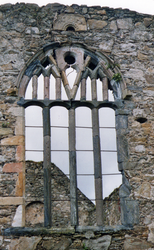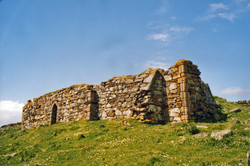
The Corpus of ROMANESQUE SCULPTURE in Britain & Ireland

Raphoe (medieval)
Church
The rectangular church was built by Sir William Stewart and almost completed by the time of Pynar’s survey in 1619 (Rowan, 1979). Incorporated into the fabric are a number of pieces of reused masonry, principally late medieval but with one possibly Romanesque window head. The window head is said to have been brought from Aughinish Island, Donegal (Kinahan, 1885-6).
Church
A nave and chancel church (9.10 m x 5.10 m on the exterior and 3.90 m x 6.60 m internally). The N and S wall and southern return of the E wall stand almost to full height. The remainder of the E wall and NE corner have collapsed. The SE quoin shaft and corbel, a plain S window and the remains of an E window indicate an early 13thc. date for the chancel. The nave is a later medieval addition, but incorporates numerous worked stones from an earlier structure in its fabric. The church stands within a modern graveyard with a second church, dedicated to St Connell, and a number of early Christian inscribed slabs. The site is located on an island that can be reached by foot at low tide.
Church (ruin)
A rectangular, rubble built church (c.13.20 m x c.5.50 m internally) with a later cross wall at the W end. The N and S walls and W gable stand to full height. The E gable has fallen and the window within it has obviously been rebuilt at some point.
Church of Ireland church and graveyard
This site, which is one of the main ecclesiastical centres in Donegal, comprises a modern graveyard surrounding an 18thc. church of Ireland church. Within the precinct of the graveyard are a number of early Christian carved stones, a Romanesque lintel and fragments from a 15thc. building, some of which have been incorporated into the church.



